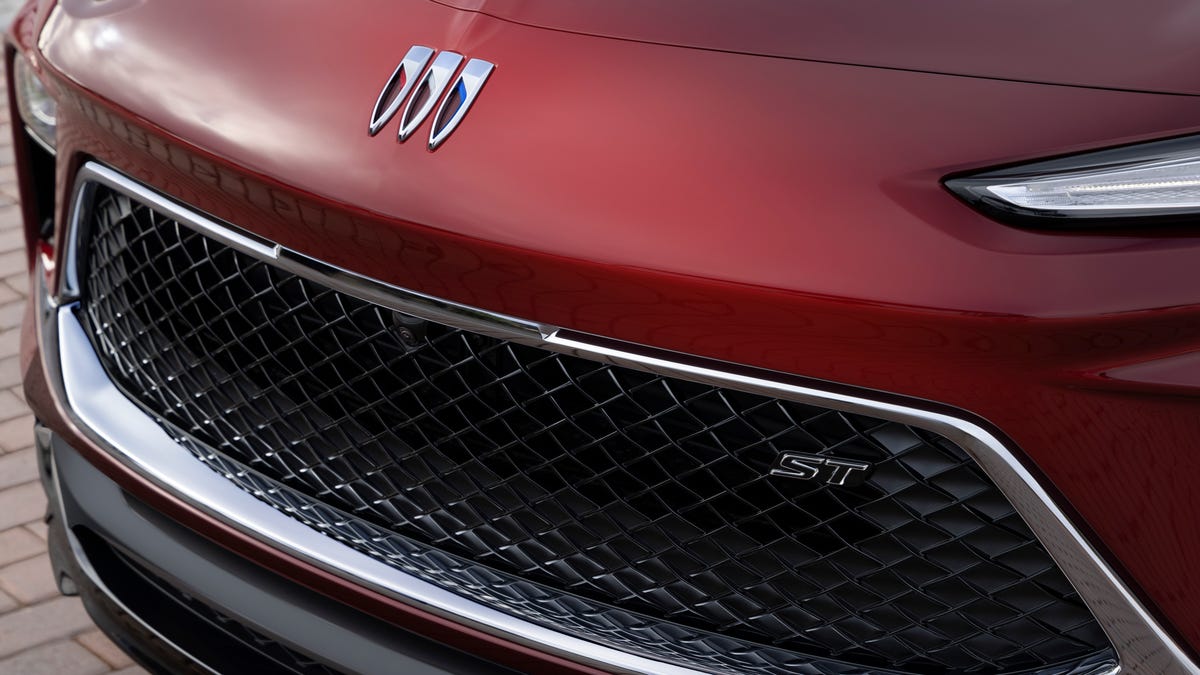Nearly half of Buick dealers are accepting a buyout offer from General Motors Co. as industry stakeholders grapple with a bumpy transition to electric vehicles.
Buick, GM’s oldest brand and its only one without an EV offering, said this week it reduced its dealer count by 47% after offering the buyout program in 2022 when it had 2,000 U.S. dealers. A similar program at Cadillac cut the luxury brand’s dealer count by a few hundred franchises nationally. GM’s GMC premier brand and mass-market Chevrolet brand did not offer a buyout program to its dealers.
GM and its competitors have asked their dealers to join them in the EV transition by investing in training, charging infrastructure and equipment to prepare to sell more battery-powered vehicles. But even as EV sales continue to hit records, they’re growing at slower rates than expected: too few charging stations, high price tags and charging speeds slower than the time it takes to fill a tank of gas have contributed to consumer hesitancy to take the plunge into full EVs.
As a result, automakers have delayed EV launches, cut back on investment plans, shrunk under-construction battery plants and nixed development programs. They’ve also reduced and delayed requirements for their dealers to meet certain standards, including the number of available charging stations, to be certified to sell EVs.
The EV proposition for dealers for now is dimming: dealers’ outlook on EV sales is worse now compared to one year ago, according to a new dealer sentiment study by Cox Automotive Inc., an automotive services provider.
“The excitement that existed a year ago around EVs has definitely faded,” Cox Automotive Chief Economist Jonathan Smoke said in a statement. “Although EV sales are growing, supply is growing faster. The EV transition is requiring more effort from dealers than before, so it makes sense that enthusiasm has declined.”
For the study, dealers told Cox they “are concerned about selling EVs and how are they going to sell them and how are they going to make any money, so it’s not surprising that so many dealers took the buyout because it’s an unknown territory,” said Michelle Krebs, executive analyst at Cox Automotive.
EV sales accounted for 7.9% of total industry sales in the third quarter, a record that was up from 6.1% a year ago and 7.2% in the second quarter, according to Cox. Higher EV inventory levels, more product availability and downward pricing pressure are helping EV sales continue to grow. They’ve increased for 13 straight quarters. Back in 2020, EV sales in the United States just had passed 250,000 for the first time.
More: Can electricity reenergize Buick?
Dealer changes at Buick and Cadillac
Buick is the second of the Detroit automaker’s brands to shift to an all-electric future, following Cadillac. The Cadillac brand also went through a dealer buyout program. Some 880 franchises under the Cadillac umbrella were required to invest at least $200,000 each to sell EVs starting this year. Hundreds of dealers opted to instead take a buyout.
In 2022, Buick unveiled the Wildcat concept vehicle to preview its future all-EV lineup. Buick is reviving its Electra name for its electric vehicles. The brand is supposed to begin its U.S. EV transition with a new model coming in 2024. Buick — which is most successful in China — does not yet have any EVs on the market in the United States. It remains focused on being all-electric by 2030.
Buick’s buyout program has cost GM about $1 billion through the third quarter of this year, according to the automaker’s financial filings.
In a statement on the buyout program, Buick spokesperson Sean Poppitt said the brand “is transforming, launching the best vehicles the brand has ever had and is the fastest-growing mainstream brand in 2023. This all needs to be supported by the best customer experience in the transition to EVs. As stated before, this year, we’ve given dealers who are not aligned with Buick’s future (the option) to exit voluntarily in a respectful and structured way, with the full support of our National Dealer Council.”
Bo Mandal, chairman of the Buick-GMC National Dealer Council and owner of a Buick/GMC dealership in Biloxi, Mississippi, said the buyout process with Buick dealers was done in partnership with the council.
“We felt like there were a lot of dealers that wanted to focus on their Buick business, and we felt like there were a lot of dealers that didn’t, and we wanted to give those dealers that didn’t an opportunity to exit the business,” Mandal said, noting a main reason the dealers wanted to take a buyout is that they have other brands they stay more focused on.
The dealers that took the buyout represented just over 20% of Buick’s average annual volume, according to the brand. The automaker declined to say how much it offered dealers in the buyout program.
“We’ve been at this for two years. I’ve had zero complaints, so that is incredible,” Mandal said. “And that just goes to show you other OEMs that try to do this in the future should take a page from Buick’s handbook because it’s really been done in partnership.”
Mandal has invested in Buick’s EV future by installing chargers and upgrading infrastructure, he said: “We know that there’s going to be a need for that in the future.”
Buick’s sales of internal combustion engine products are up 63% for the year. The Envista, the brand’s latest entry, has been a shining star for Buick. The small SUV hit dealerships this summer with a price tag of $23,495.
Mandal called the Envista “the most groundbreaking, hotter than a firecracker Buick product that we’ve had in a long time. I’m optimistic about where the future is, and it’s an important part of GM’s brand. It’s important part of their makeup.”
Chevrolet, GM’s volume brand, has 2,900 dealers. The brand has sold 1.3 million vehicles this year, compared with 124,868 at Buick.
Chevrolet spokesperson Chad Lyons said 86% of the total Chevrolet dealer network has enrolled as an EV dealer for the brand. That means they’ve met all EV requirements, including installing and having operational EV chargers at their facility, have service equipment and tooling and provided training.
Stellantis and Ford dealer transition
Meanwhile, GM’s crosstown rivals have launched certification programs for its dealers to sell EVs. Roughly two-thirds of Ford Motor Co.’s U.S. dealers had opted into the voluntary Model e certification program last year. Participation has stabilized at about half of its dealer population now — roughly 1,550 dealers have signed up, down from 1,920.
“This enrollment level,” spokesperson Marty Günsberg said in an email, “places 86% of the population within 20 miles of a Ford dealership capable of selling and servicing a Ford EV.”
Last month, Ford reduced its requirements to be certified. They include fewer training requirements and fewer chargers on site as the automaker pulls back on $12 billion in EV investment plans. The Dearborn automaker cited charger supply chain and infrastructure delays for the changed requirements.
The program also faced litigation challenges from several dealers: the Illinois Motor Vehicle Review Board last month ruled in favor of 26 retailers challenging the legality of the requirements, a decision Ford has said it would appeal.
Now, Ford dealers have to have two Level 2 chargers by June 30, down from five. To be “certified elite” for which most dealers who signed up opted, stores must have three of those chargers instead of five. The additional stipulation to have a Level 3 charger for 2026 has been removed, too. Without certification, dealers can continue to sell internal combustion engine and hybrid products. The original retirements had called for dealers to invest about $500,000 to be certified and up to $1.2 million to be elite.
Stellantis NV is bringing its first all-electric vehicles to the North American retail market next year. In 2022, it said its goal was to have the infrastructure completed at all of its more than 2,600 U.S. dealers for EV certification by the end of the first quarter of 2024.
In a recent statement, Phil Langley, Stellantis’ head of network development in North America, said the company’s date for ordering equipment and selecting an installer is March 31.
“We are aware of some supply chain issues with charging equipment and electrical grid challenges,” he said. “We anticipate that these smaller, more rural areas will need some additional time, and we have built flexibility into the plan to accommodate that challenge. We will begin the EV Dealer Certification process shortly after the first of the year and expect that process to continue through the end of the 2nd quarter of 2024.”
Charging infrastructure requirements are based on anticipated EV volume sales but do include a Level 3 DC fast charger. Certification also includes special tools, personal protection equipment and training. Without certification, dealers will have limits on the products they can offer.
“We’re not going to have the entire dealer body be ready full-blown on April 1. That’s not going to happen,” Nyle Maxwell, CEO of the Nyle Maxwell Family of four dealerships in Texas and chairman of the Stellantis National Dealer Council, told The Detroit News last month of the originally stated first-quarter deadline. “For the Level 3 chargers, some of the utilities can’t provide us the voltage necessary.”
Fluid conversations have been ongoing with Langley and Stellantis’ dealer network personnel, Maxwell said. Utilities are grappling with having the workforce and qualified electricians to install the voltage necessary for fast chargers.
Maxwell says his dealerships have chargers. Sellers in more rural areas, though, aren’t expecting the EV demand seen in more metropolitan areas, and with some forecasts suggesting new technology could make Level 3 chargers more affordable in the next two years, some may want to hold off.
“We’re going to be at the mercy of these charging stations being available,” Maxwell said of EV demand. “Not everyone is going to pay $1,000 for a Level 2 charger for the convenience of having it right in their garage. The acceptance and marketability of these are going to be dependent on a lot of things. Can I feel secure if I buy this fully electric vehicle? Am I not going to get stuck somewhere?”
Plus, EVs are more expensive than their engine-running counterparts. The knowledge of a key presidential election next year also adds to the uncertainty. Leading Republican candidates say they would pare back the more aggressive emissions standards proposed under the Biden administration.
“There are a lot of things still up in the air,” Maxwell said.
Kevin Farrish, dealer principal of a Stellantis dealership in Fairfax, Virginia, and vice chair of the council, said he thinks Stellantis’ requirements are reasonable and that company leaders have been willing to work with retailers. For example, dealers are able to rent a forklift for use in their service department versus owning one outright.
“My gut tells me they’re pushing harder for the metropolitan dealers to have EV capability for sales,” Farrish said. “That’s where predominantly the sales are going to come from, which makes sense. Beyond that, I don’t know of any real pressure.”
X:@bykaleahall
X: @BreanaCNoble

Jessica Roberts is a seasoned business writer who deciphers the intricacies of the corporate world. With a focus on finance and entrepreneurship, she provides readers with valuable insights into market trends, startup innovations, and economic developments.







